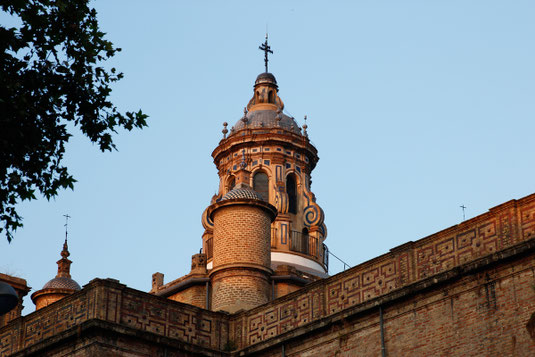One Thousand and One Nights: The 5 Most Beautiful Buildings and Places in Andalusia.
August 26, 2018
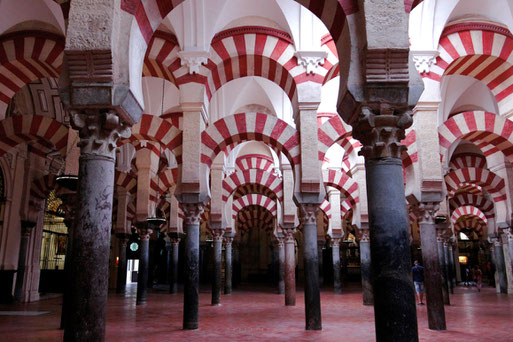
The cold water is shooting out of the shower and over my toes. 107 degrees shows the flashing green sign at the pharmacy. I want to run there and see if they have a pair of new feet on offer. Because mine are, unfortunately, junk. We are in Seville, the last place of our three-week road trip through Andalusia. Actually, we just wanted to take a short ride through the old town in the morning. But then it was so beautiful that we accidentally mackerelled for six hours over hunchbacked cobblestone.
My head explodes with chessboard-like church towers, colourful facades and ornate tiles. In addition to breathtaking nature, Andalusia also has wonderful architecture and old towns, where the alleys are so narrow that you have to fold in both side mirrors to be able to drive through with short-term heart rhythm disturbances. After the five most beautiful natural wonders, I now introduce you to the five most fantastic places and buildings that you absolutely must have seen here. Between never-ending arches, shining bridges and a city that is completely blue. Of course with tips and tricks to make everything work!
1. The Alhambra of Granada
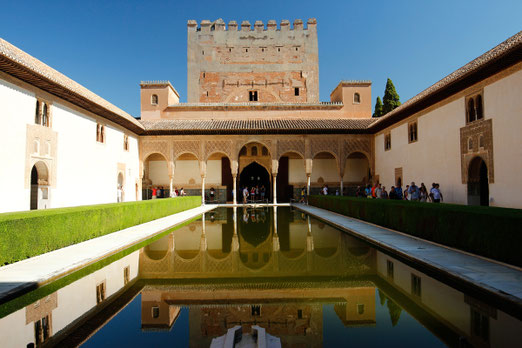

The Alhambra is a Moorish fortress. It was first mentioned in documents in the 9th century. It lies on a mountain and covers an area of about 1.506.947 square feet. Pretty chic and almost as big as my apartment at home. The huge gardens smell of flowers and herbs, the hedges are cut into onion-shaped arches and the cobblestone pavement reflects in the sun. But all this is nothing compared to what opens up behind the walls of Nasrid Palaces. Ornaments as fine as golden hair, arches out of "One Thousand and One Nights", fountains pouring over marble and domes disappearing like crystal caves in the heights of stone ceilings. Sometimes I look up and think I'm right under the starry sky. Sometimes I get dizzy from the twisted columns that frame an entire courtyard and I almost slip out and fall into an artistic water channel because I forget to look straight ahead. You can schedule a visit to the Alhambra for at least three hours.
Later you have a great view of the fortress and the roofs of Granada from Mirador de San Nicholas (especially in the evening).
2. The Puente Nuevo of Ronda
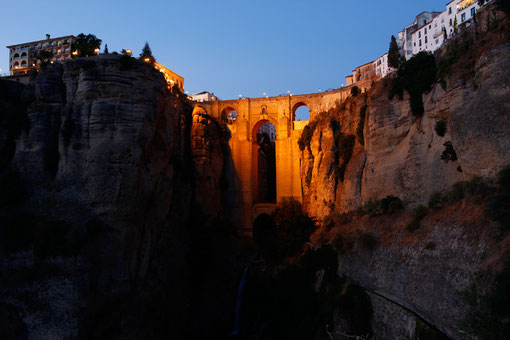
As the night pushes towards the horizon and the sun shifts over the edge of the sky, the orange headlights on Puente Nuevo in Ronda slowly light up. Like a gateway to another world, the bridge shines between the 400-feet-high rock walls of the El Tajo gorge. The Puente Nuevo, the "New Bridge", is not as new as it might sound, but was built between 1751 and 1793. So the project took almost as long as the construction of the Elbphilharmonie in Germany (just a German joke, because building the Elbphilharmonie took much more time and money than expected until everyone was laughing about it).
The bridge consists of three arches and connects the new Old Town of Ronda with the totally old Old Town. Both districts are very beautiful. You have a great view of the bridge from Mirador de Cuenca as well as from a dusty hiking trail, which starts at Plaza de Maria Auxiliadora. It is marked with the encouraging words "Real Rist of Death" - which sounds a bit more dramatic than it was at the end. Just in time for sunset, the bridge and a part of the valley are illuminated from both sides and seem to glow like a candle in silence. Meanwhile, a waterfall rushes down towards the Old Bridge and is swallowed by the turquoise Rio Guadalevin. You do not have to pay entrance fees at any of the points mentioned.
3. The Mosque–Cathedral (Mezquita) of Córdoba
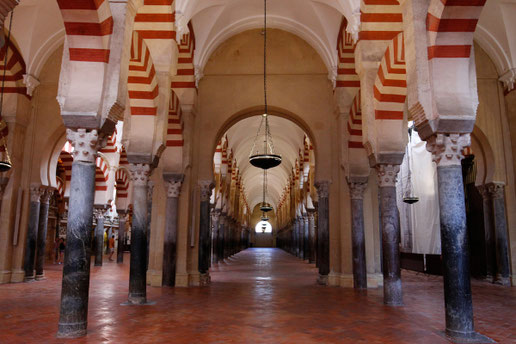
856 columns stand asymmetrically in the middle of the hall, connected by coloured arches. I want to spread my arms and walk between them like a child. It's a feeling like curtains are opening and stars are raining down.
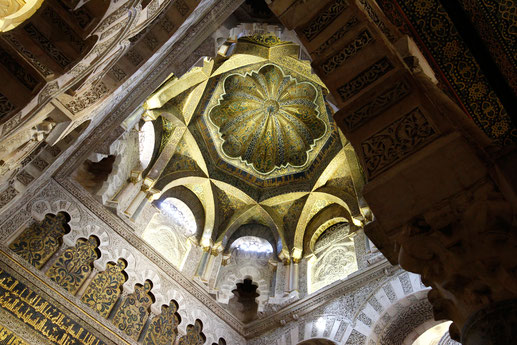
Next to the large hall with its arches there is the Mihrab with a horseshoe arch so richly decorated with mosaics that it seems to be the entrance to a fairytale castle of gold and diamonds. If you look up here, you will see a dome that is so gigantically beautiful that it seems as if all this were not real.
The Mezquita has been a UNESCO World Heritage Site since 1984. You can easily spend two hours inside of the building. A great thing is that you don't need to make an online reservation, because you can simply go to the ticket office and buy a ticket for $12 [August 2018] without being overrun. Of course it is advisable to be there as early as possible to enjoy an undisturbed atmosphere. Also the park in the inner courtyard with its small fountains and palm trees is very beautiful. Above all it's shady, if you come stumbling somewhat tiredly out of the cathedral-mosque mosque-cathedral. The dress code in the building is quite loose, even if the signs at the cash desk say otherwise. When I stood in top, shorts and flip-flops in front of the entrance and inconveniently took my scarf out of my backpack to cover my shoulders, the security man just laughed, waved and indicated a bikini with a grin. However, a woman with her back cut out wide had to wrap herself up a bit. Tripods are unfortunately not allowed in the Mezquita!
4. The Blue Village Júzcar
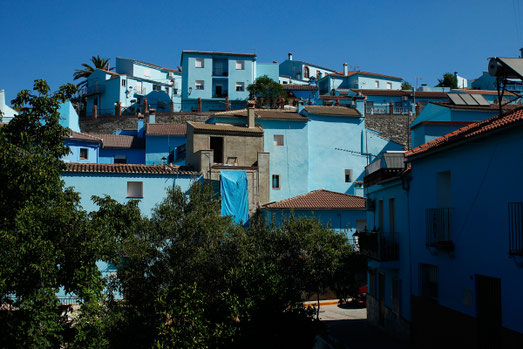
From Marbella to Ronda, you climb the mountain roads carved into vertical rock faces, curve by curve. Somewhere the sea is still shining, disappearing behind pines. I have to brake again because it's getting a little hairpinny. Between the two cities are numerous small mountain villages. White as snow they shimmer between the desiccated and massive mountain landscapes. Andalusia is known for this. But one city falls out of the frame like a flamingo. A blue one. It is the municipality of Júzcar with about 200 inhabitants.
Even from far away the houses glow like the sky. All of them. Because of the world premiere of the movie "The Smurfs" on June 16 in 2011. Sounds crazy, doesn't it? The village has simply decided to paint all facades. 1400 gallons of paint were used, organized by Sony Pictures. Even the town hall and the church turned blue. After that, the majority of the population voted to leave it as it is, which has attracted about 80,000 tourists a year since then. Also me. I am more interested in the architecture and the exciting play of colours with blue stairs, towers and railings than in the film. Nevertheless we see smurf figures and drawings of the characters on the walls everywhere. Well, I don't really need that, because it looks more or less childish and kind of ridiculous. But when you look beyond that, it's just fascinating to walk through the narrow streets as if you were in an oversized swimming pool.
There is no entrance fee and it is better to park you car at the small road leading into the village, because inside of the city there is nearly no parking space.
5. The Old Town of Seville
